What are the top GivingTuesday best practices and fundraising ideas to make you stand out in 2024?
Since 2012, GivingTuesday has become a worldwide day of (mostly) online giving. Set on the Tuesday following Thanksgiving, GivingTuesday is as famous as the shopping events like Black Friday and Cyber Monday that precede it. Throughout the years, GivingTuesday has only grown in popularity with millions of people coming together to celebrate generosity, share kindness, and drive giving.
In 2023, GivingTuesday in the United States alone saw an astounding $3.1 billion in contributions, with 34 million adults participating in the giving. Despite annual donations decreasing the 2023 CauseVox Giving Study found that individuals, especially the younger demographic, remain steadfast in their commitment to philanthropic endeavors.
Planning for GivingTuesday 2024
It’s no secret that you have the opportunity to capitalize on the momentum of GivingTuesday to fundraise for your nonprofit: the challenge is what GivingTuesday best practices and ideas will help your nonprofit capture attention?
GivingTuesday has historically been famous for engaging audiences on social media. The CauseVox 2023 Giving Study found that among the younger generations, 76% said that social media influences their decision to make a charitable gift. These numbers underscore the importance of vibrant, engaging content that resonates.
Amongst the older generation, they are pretty neutral on most communication platforms apart from phone and text messages. 73% of the survey participants stated that these methods had little to no effect on their giving decision.
Regardless of who your target audience is, it is important to communicate clearly, authentically and effectively.
With GivingTuesday 2024 coming up on December 3rd, the time to start planning is now. To help your nonprofit get in on the conversation and stand out on GivingTuesday, here’s our top GivingTuesday 2024 best practices and fundraising ideas:
- Prepare Early
- Set Goals
- Show Progress
- Enable an Impact Meter
- Tell Good Stories About People
- Create a Video
- Engage Your Supporters Throughout the Day
- Drive Large Gift Commitments With Pledges
- Get A Matching Grant
- Make Partnerships
- Boost Revenue by Selling Exclusive Merch
- Consider a Soft Launch
- Use Peer-to-Peer Fundraising To Raise 2x More
- Incorporate GivingTuesday Into Year-End Giving
- Capitalize On Social Media
- Test Your Donation Form
- Thank Your Donors
Free Download: Complete Year-End & GivingTuesday Fundraising Toolkit:
1. Prepare Early
One of our top GivingTuesday best practices for 2024 is to start preparing your campaign early (aka, now).
In surveys from past GivingTuesday campaigns, many organizations noted they anticipate spending more time preparing for their campaign in future years. Campaign planning is the ideal way to ensure your campaign goals align with your organization’s goals.
If you can spend just a few hours in the upcoming weeks brainstorming your campaign, you’ll be ahead of the curve. Here are a few things you should discuss with your team as we head towards the holiday season:
- Themes to tie your fundraising together.
- Fundraising techniques, such as peer-to-peer, crowdfunding, and special event fundraising (especially if you’re looking at how to move your events to virtual).
- Potential corporate or major donor gift sponsors/matches.
2. Set Goals
GivingTuesday is inherently a short-term initiative, so having a specific fundraising and impact goal set for your campaign has been proven to help drive urgency and donations.
Here’s why having a fundraising thermometer, countdown, and impact goals are specifically important for GivingTuesday:
- Demonstrates the need to your donors
- Drives urgency for donors to participate in reaching the goal.
- Shows your progress so your donors visually see how their donation moves the needle.
- Allows donors to celebrate with you when your goal is achieved.
But goals don’t have to be just dollars. Including an impact goal alongside your fundraising goal ties dollars to impact – and 68% of donors agree that knowing how their donation makes an impact is important to their gift.
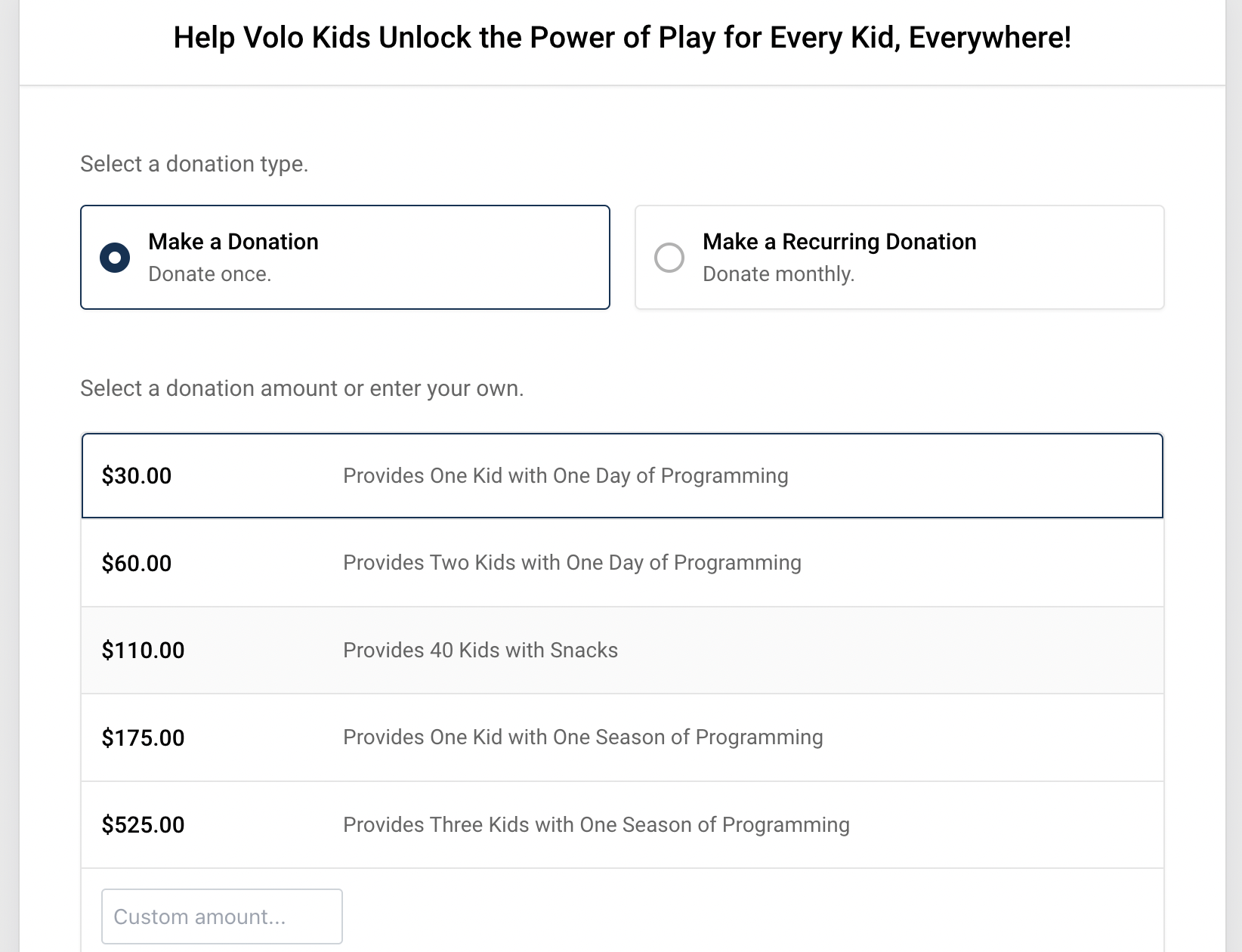
By including the impact of each monetary donation, Volo Kids donors can see just how their dollars are being used.
You can make this even more effective by making frequent updates on their progress throughout the day on social media. This ultimately builds momentum for the campaign.
This GivingTuesday, think about the ways your organization can set SMART goals to give your campaign a more relatable target.
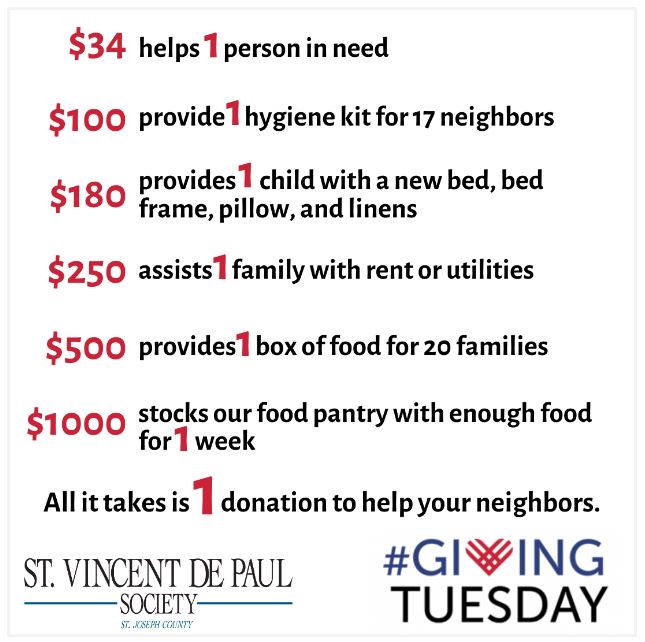
Consider setting any one or more of these goals:
- Awareness: How many people do you want to educate about your cause?
- Donors: How many donors are you looking to get overall? How many new donors are you looking to attract?
- Financial: How much do you want to raise?
- Personal fundraisers: How many individuals are you looking for to raise funds for your cause?
- Impact: How much impact do you want to see from the funds raised? How much money does it take to create this impact?
- Partner: How many partnerships are you looking to build?
- Pledges: How many people do you want to pledge a donation to the cause?
- Reach: How many impressions do you want your campaign to get on social media?
- Volunteers: How many people do you want to commit as volunteers?
Perhaps not every one of these goals will apply to your campaign, but it’s still important to assess which goals you want to set. Not only do the goals give you a good way to communicate with potential donors, they’ll also help you build out your plan as you move forward.
You can easily reflect your fundraising goals, end date, and impact on GivingTuesday using CauseVox’s free crowdfunding sites. Build your GivingTuesday campaign for free in 30 minutes using CauseVox.
3. Show Progress
Since a GivingTuesday campaign is usually a shorter, time-bound campaign, it’s important to showcase fundraising progress as donations roll in, in real-time.
Fundraising thermometers and progress bars are one of the most basic forms of gamification (taking elements of game play and integrating those elements into non-game scenarios such as fundraising). They provide instant gratification for your donors and can help ramp up engagement (and donations!). It’s psychological and it works because both the goal and how close they are to reaching it are front and center. Check out our free fundraising thermometer here!

4. Enable An Impact Meter
These days, donors are more focused on impact than ever.

There’s no better way to see the immediate impact of a donation than through an impact meter, like peer-to-peer fundraisers David and Nathan did for Raising Hope. The impact meter shows the number of session provided and how close you or your organization is towards reaching its goal. It reinforces what you’re doing with why you’re doing it.
These handy tools located directly on your nonprofit and personal fundraisers’ fundraising websites track the campaign’s progress and intended impact in real time. Seeing what their gift is poised to do may be the extra push needed for individuals who are on the fence about donating on GivingTuesday.
5. Tell Good Stories About People
The power of story lies in its ability to connect us on a deeply human level. In order to do that, you have to tell a good story that shows donors who they’re helping and how it works. Make your donors the hero’s of the story, you are simply a guide to helping them steward their money well and have a profound impact on the world
The Bill and Melinda Gates Foundation partnered with GivingTuesday to develop the #MyGivingStory initiative: a space for donors, volunteers, and nonprofit staff to tell the story about why they give. This initiative helps an organization’s supporters find the words and inspiration they need to activate and rally others to get involved.
Stories help to connect people. Not only that, but they help your donors to place themselves in your organization’s work: they can see what their role is and how it impacts someone else.
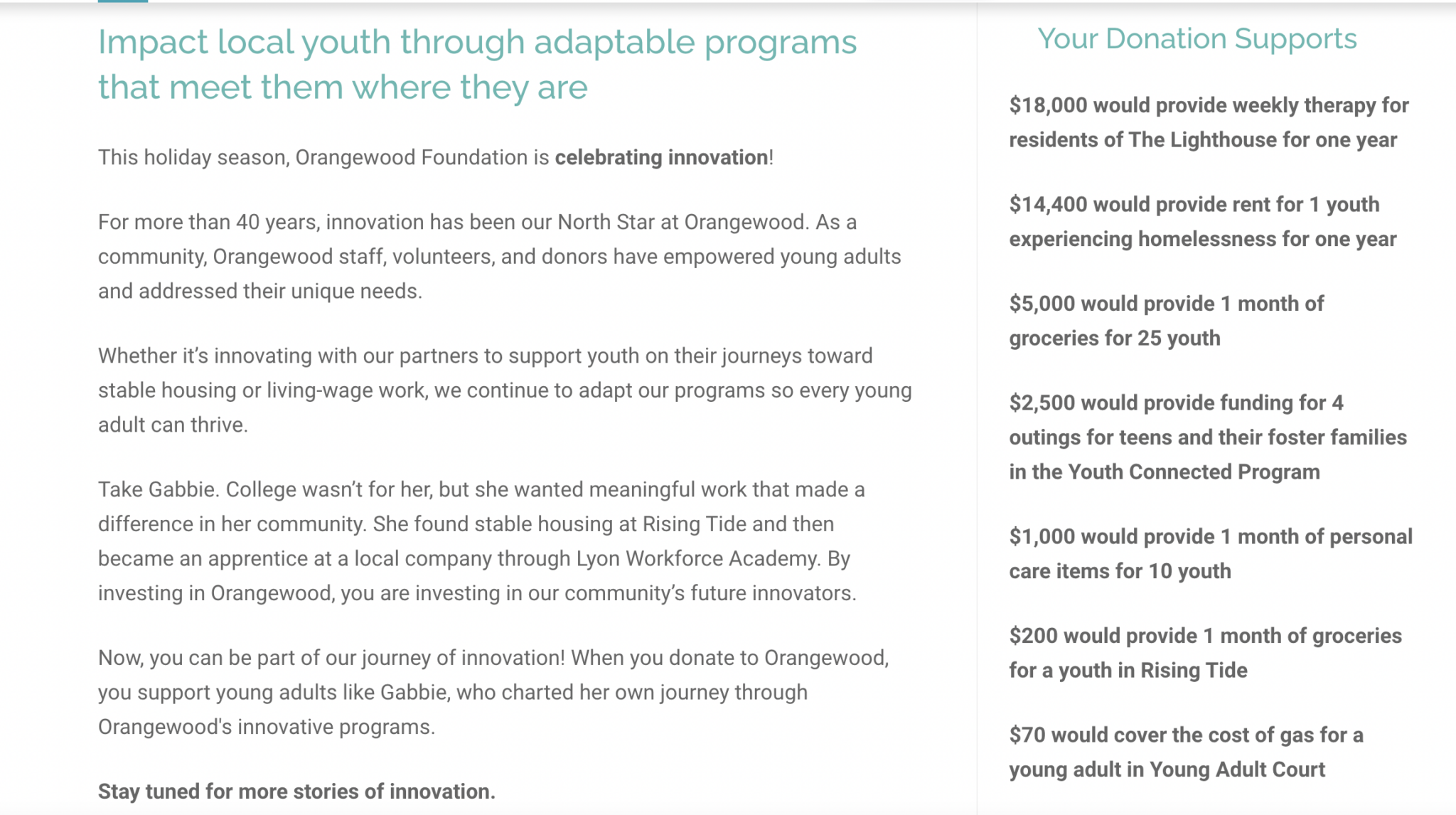
The Orangewood Foundation included a powerful story in their giving campaign that highlights their impact through beneficiaries experiences. By telling the story of someone your organization has helped (with their permission) or sharing the reason why a donor is giving, you are putting your audience in their shoes, fostering empathy. This empathy is the inspiration that activates your donors to give.

For GivingTuesday 2024, think through what stories your nonprofit has to share and how you want to share them with your online audience. One of the easiest ways to make this happen is to get your supporters involved.
Get your supporters involved in your storytelling:
- Ask your donors to tell #MyGivingStory, but be sure to ask them to tag your nonprofit in the post
- Create your own hashtag storytelling challenge or picture sharing challenge on social media. (ie Volo City Kids Foundation asks their donors to change their profile picture to a childhood picture of themselves playing a sport)
- Give them the opportunity to create their own personal fundraising page, where they can share their own story and fundraise on your behalf on GivingTuesday.
You can use their direct testimonials to build out larger stories to share.

6. Create a Video
If a picture is worth a thousand words, then a video must be worth…so much more. An impactful video is a powerful tool that rallies support by igniting our passions and stirring up our emotions.
80% of the highest-grossing campaigns on CauseVox have embedded videos on their online fundraising campaign. In fact, 57% of people who watch nonprofit videos go on to make a donation.
Making a quality video isn’t easy. It’s going to take planning and time. When it comes to creating a powerful and compelling nonprofit video, you want to make sure you’ve hit on the following:
- Set a goal – Whether you’re wanting someone to donate or showcase impact, setting a goal will help determine the overall message of your video.
- Share compelling stories – Show, don’t tell your viewers by providing testimonials and interviews that illustrate journeys from trial to triumph.
- Have a clear call to action – If you want your viewer to donate – make sure it’s clear.
- Keep it simple – You may have grand ideas but we recommend not getting too ambitious and coming out with a sloppy product. In other words, keep it simple!
- Share your video – Once you’ve completed your video, it’s time to put it out to the world! Blast it out on social media, include it on newsletters, or feature it on your website.
Pro Tip: Keep the message of your video positive even when presenting tough or uncomfortable topics. It’s not what you say but how you frame it.
7. Engage Your Supporters Throughout The Day
Once your campaign is in full-swing, engage with your supporters and keep them updated throughout the day.

Here are a few top-notch communication and engagement ideas to get you started:
- Post regular updates about your fundraising progress on social media (“With 5 hours left on GivingTuesday, we’re only $5,000 away from meeting our goal.) This is a great way to celebrate wins as they come but also helps to create a sense of urgency and encourage people to donate.
- Share how the funds raised so far will help the communities and populations you support. Ex: (“We’ve raised $5,000 so far to provide meals to 5 families for one month”)
- Go live on Instagram and Facebook to interact with your donors
- Use Instagram reels and Facebook stories to do shoutouts and updates.
- Consider giving your donors a personal, behind-the-scenes look at GivingTuesday at your nonprofit
Remember, your donors are participating in GivingTuesday but it’s so much more than just one day. They’re part of the greater movement for change.
8. Use GivingTuesday To Drive Gift Commitments With Recurring Or Pledge Donations
GivingTuesday doesn’t have to just be one day of giving: you can use GivingTuesday as a day to inspire a long-term commitment to generosity.
Running a recurring giving campaign or a pledge campaign is one of the top GivingTuesday 2023 ideas that will help you stand out and drive more donations year round. Here’s why:
- Recurring donors have a 90% retention rate, as opposed to 45% for one-time donors
- Recurring donors give 42% more annually than one-time donors
- 81% of Americans donors surveyed said they would give more if they could commit to a large gift and pay in installments using a service like Causevox’s pledge donation functionality.
Using pledge donations, you could get more large gifts committed to your organization on GivingTuesday, broken up into installments that would be automatically fulfilled over the course of 12 months. For example, a donor could pledge to give $1000, broken up into 12 monthly installments — making it an easy $83/mo payment.
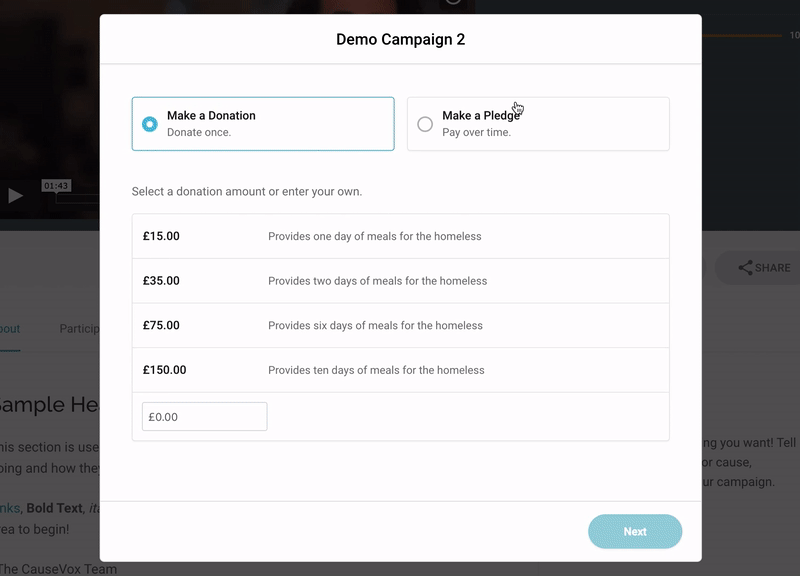
This year, don’t miss out on the opportunity to drive gifts year-round, beginning on GivingTuesday. Even if you only get a small commitment upfront, you’ll set yourself up for ongoing fundraising success throughout 2024.
The spirit of GivingTuesday isn’t just meant to be one day; it’s a global movement of generosity. Getting donation pledges and recurring gifts may be the best ask you can do this GivingTuesday.
Learn more about how you can use CauseVox’s pledge feature to get more large gifts committed through installed payments.
9. Get A Matching Grant
One of the top-performing GivingTuesday fundraising ideas and best practices is having a matching gift in place. A sponsor or donor pledges to match donations up to a certain amount for a specific dollar amount or amount of time. For example, a donor or donors can commit to matching gift up to $5000, or will match all donations given between 3-6pm on GivingTuesday.
In fact, mentioning matching gifts in fundraising appeals has been found to increase the response rate by 71% and result in a 51% increase in the average donation amount.
This has been proven time and time again as one of the top GivingTuesday fundraising strategies. For example, Adult Congenital Heart Association has been using matching gifts to blow their GivingTuesday fundraising goal out of the water for the last 5 years. Last year, they raised over $50,000 — twice their goal — with the help of a $15,000 matching grant challenge donated by their board of directors.

To secure a matching gift for your GivingTuesday campaign, try asking:
- Your board
- A major donor
- A group of donors that have given annually
- Or, reposition a gift that’s already been pledged as a challenge grant

Letting donors know that their dollars will be doubled is a huge motivator and a great idea to help you stand out on GivingTuesday 2023.
For more tips, here are 5 ways you can effectively market your matching gift.
10. Make Partnerships
GivingTuesday isn’t just about soliciting donations from your audience; it’s about drawing attention to your cause and building relationships with current and prospective supporters.
Henry Timms, the founder of GivingTuesday, noted, “Giving can be transactional, but at its best, giving creates life and shares warmth. Giving is empathy in action.”
Giving is about collaboration and working together to create positive impact. Timms even credits that collaboration with GivingTuesday’s rapid growth.
We can see from past GivingTuesday campaigns that truly successful organizations do it with partners.
One great example of partnerships is the Give Local initiative hosted by Spur Local. This organization didn’t focus on raising funds for themselves, but instead spent their GivingTuesday sharing other causes.
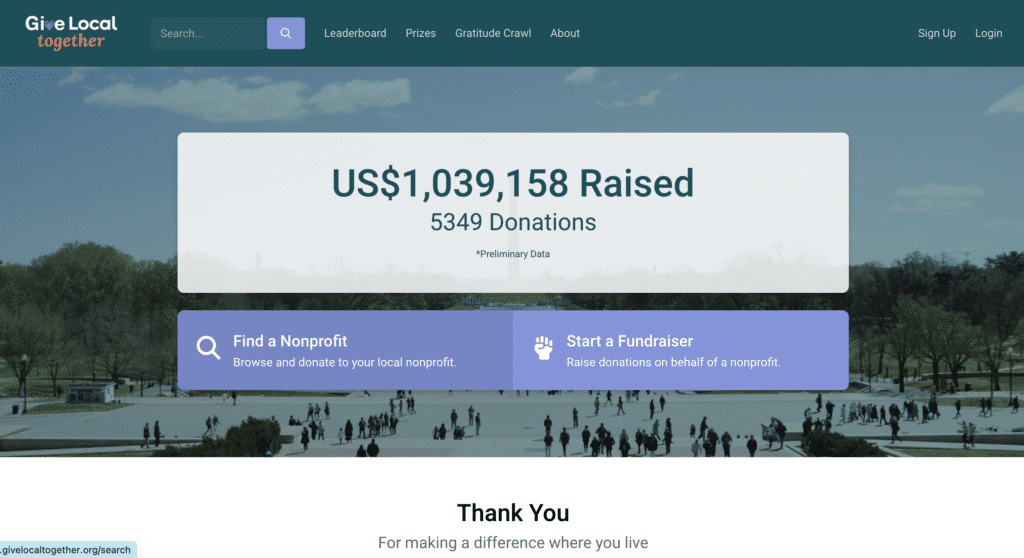
This partnership gave donors a sense of confidence in the nonprofits that Spur Local highlighted. Plus it allowed Spur Local to focus on one of those non-monetary goals we mentioned earlier: awareness. They got to spread their message and increase awareness of their own goals.
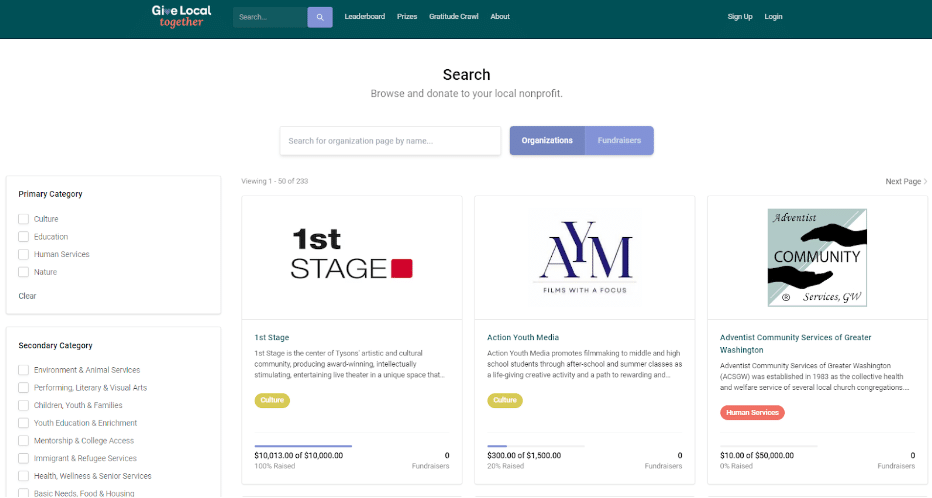
When nonprofits work together using the same media kit, social media hashtags, and share one another’s campaigns online, beautiful things happen. These actions foster community engagement and give the community something to rally around. This can be especially powerful when you connect with other local organizations and focus on building community in your area.
This year, consider expanding your partnerships with corporations, local businesses, marketers, and other nonprofits to increase your exposure and build new relationships.
Here are a few ways your organization can partner with others:
- Obtain a matching grant from a corporation that shares the same community values and vision as your own
- Find businesses that support your cause and ask them to leverage their networks for your campaign, donate a portion of sales on GivingTuesday, or donate their product/space to host an event
- Connect with other nonprofits that have supplemental services to yours and consider running a joint event or a competitive campaign
- Reach out to marketing agencies to donate a certain amount of media for your campaign
- Research influencers or celebrities that care about your cause and ask them to be an advocate
- Develop a relationship with media outlets in varying mediums (print, digital, video, etc.) to get the word out about your campaign
If all that sounds overwhelming, we’ve got a few tips to help make it a bit easier:
- When working with a business, also cater to their employees. Offer opportunities to engage such as by becoming a personal fundraiser.
- When building a partnership, make sure expectations are clear on both sides. The relationship should be two-sided.
- Provide a toolkit for your partners to promote your campaign on social, through email, on their website, and in person. Offer customization to better reach the partner’s audience as needed.
- Follow up with a thank-you note after the campaign ends and ask your partners for feedback.
11. Boost Revenue By Selling Exclusive Merch
Incentivize giving by offering your donors a little something in return for supporting your cause.

If you have the bandwidth, setting up an online store is a great way to boost revenue.
There’s no shortage of popular branded items you can sell:
- Stickers
- Shirts
- Exclusive GivingTuesday swag
- Travel Mugs
- Hats
- Reusable Totes
Be sure to promote your store by linking it in your campaign, including it on email blasts, or by sharing it on social media. What makes this even better is that an online store doesn’t have to be used exclusively for GivingTuesday. Also, when someone uses or wears your merch, they’re effectively increasing visibility to your cause and promoting your org.
12. Consider A Soft Launch
A soft launch is an “unofficial pre-campaign” where you share your GivingTuesday campaign with a small group of individuals. Share with your staff, board of directors, volunteers, and most generous/enthusiastic donors before fully kicking-off.
The purpose of a soft launch is to solicit feedback and create social proof for your GivingTuesday campaign before you share it out to the world.
By front-loading donations and generating support in advance, people view your cause worthy and are more inclined to donate, maximizing the success of your GivingTuesday campaign.
When it comes to timing a soft launch, aim to start three weeks in advance and no later than one week before GivingTuesday. We recommend setting a soft launch goal to raise a certain percentage before your official launch – ideally, somewhere between 10-30% of your overall goal.
A soft launch does take a bit of work upfront but once GivingTuesday rolls around, you’ll have built up momentum around your campaign!
13. Use Peer-to-Peer Fundraising To Raise 2x More on GivingTuesday
Peer-to-peer fundraising campaigns help you engage your audience to fundraise on your behalf: so you reach new networks of donors you would have never reached before, while at the same time building your community.
And, since GivingTuesday has always been focused around individuals giving back, peer-to-peer fundraising is the perfect ask: it gives your community members a tangible way for them to participate in GivingTuesday for your organization and allows them to tell their own stories.
Here’s how using peer-to-peer fundraising will help you stand out on GivingTuesday 2023:
- It exponentially increases your network to everyone your fundraisers share their page with.
- Social media prioritizes individuals’ posts (above company/organizations’ posts). This means your fundraisers will organically get more traffic and engagement on social media.
- Individual’s emails will stand out in a crowded inbox – above the many emails sent directly from organizations
- You’ll drive more donations: peer-to-peer fundraising tends to drive about 2x as much as crowdfunding.
- Peer-to-peer is a primary driver of new donor acquisition. SOS Children’s Villages shared that 75% of their new donors all year came through their year-end peer-to-peer fundraiser.
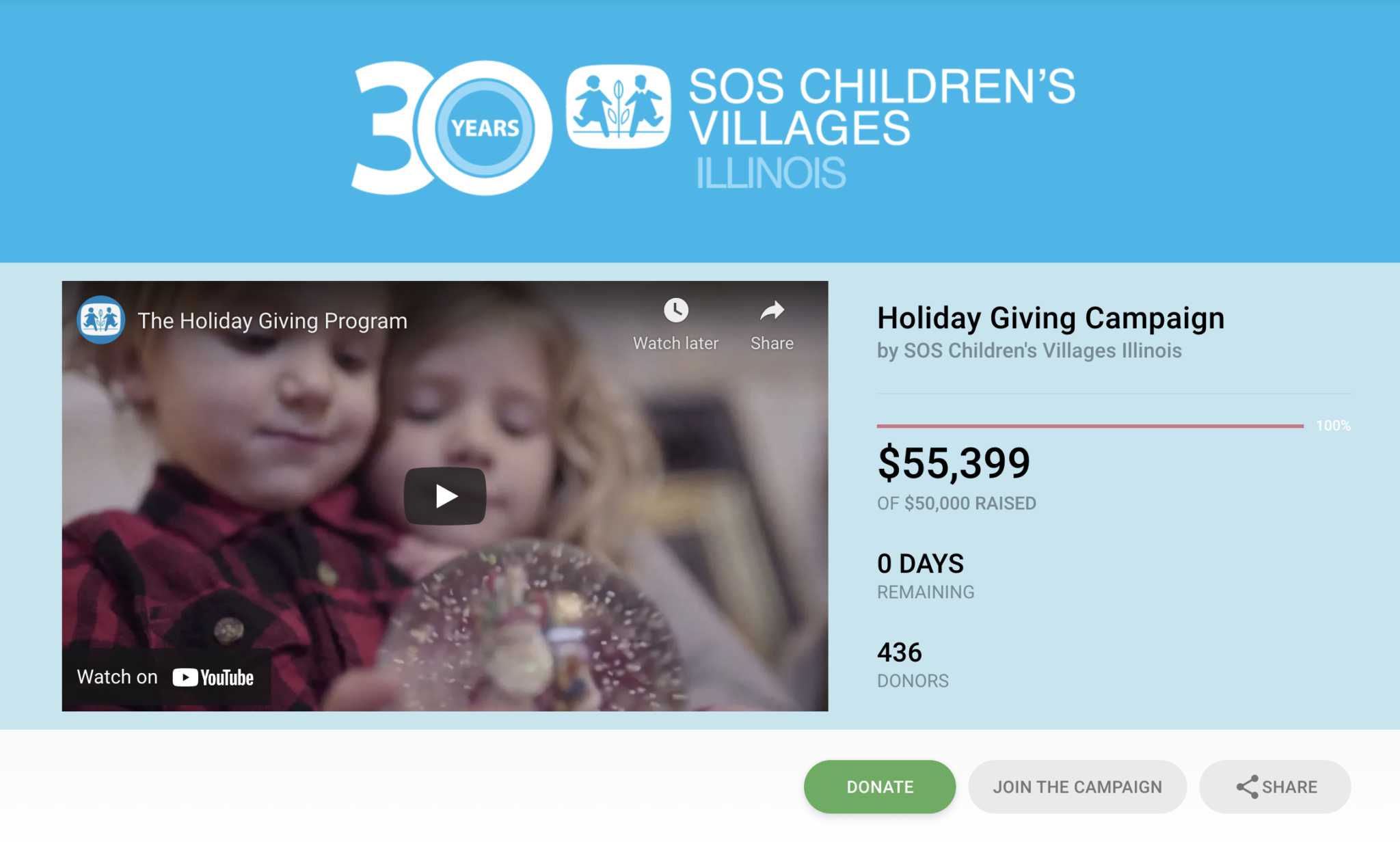
The Council for Exceptional Children has peer-to-peer fundraisers sharing their personal stories and inviting their networks to give. Together they have raised over $15,000.

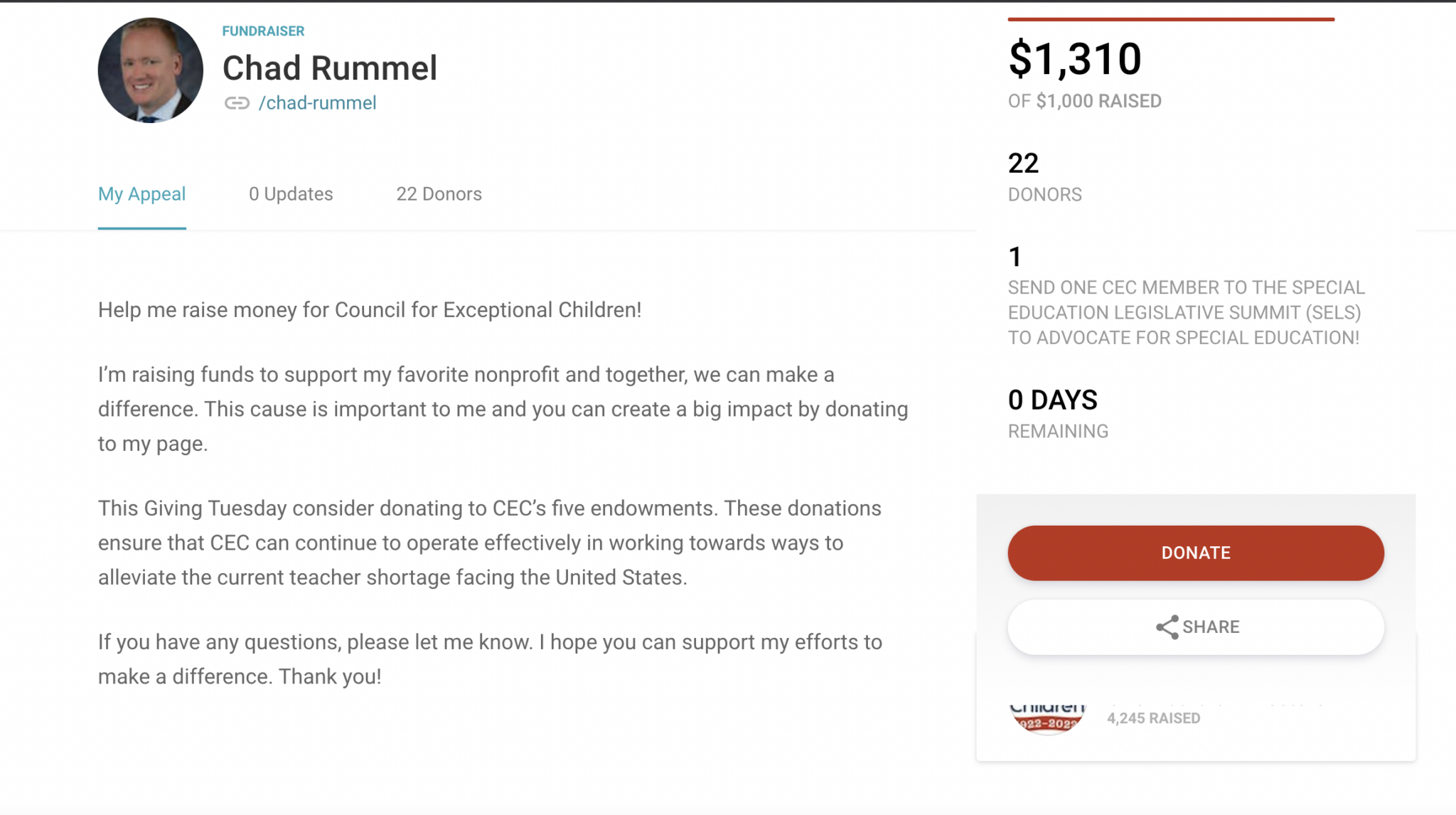
Stand out on GivingTuesday with peer-to-peer fundraising! Build out your peer-to-peer fundraising campaign with CauseVox for free.
14. Incorporate GivingTuesday Into Year-End Fundraising
Since 2012, nonprofits have incorporated GivingTuesday into their year-end fundraising and seen amazing results. In fact you’ll probably notice that your year-end strategies will be very similar to your GivingTuesday strategies.
Think of GivingTuesday as the launch pad for your larger year-end fundraising campaign. It’s the day you start telling the story you’ll tell for the rest of the season. It’s the first hard ask.
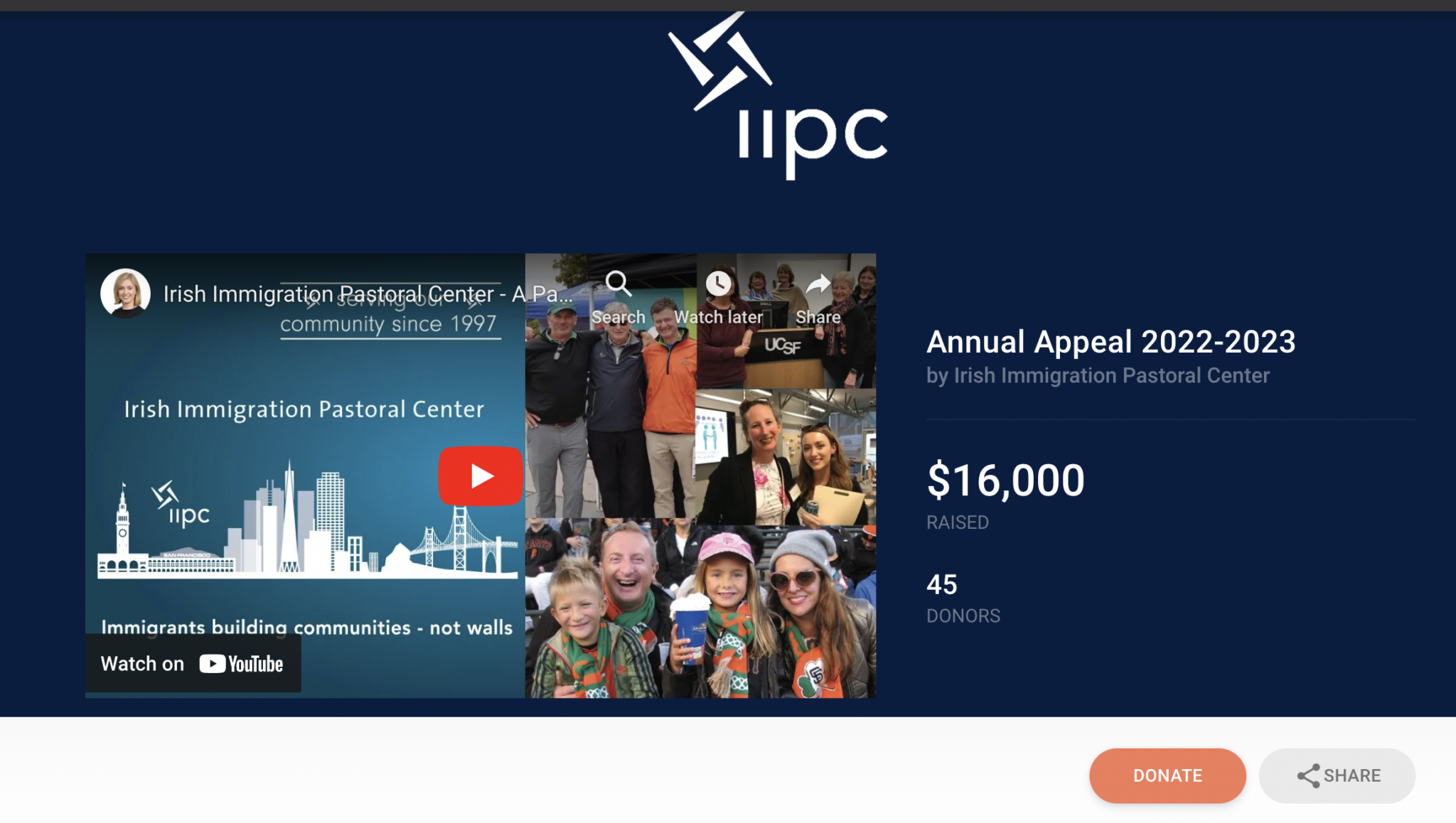
The Irish Immigration Pastoral Center launched their GivingTuesday campaign as an Annual Appeal. This helped them to kickstart the giving season by launching, yet not limiting, giving to GivingTuesday.
Participate in GivingTuesday with a clear fundraising goal for the day, but keep talking about how that figures into your larger year-end goal. Make it clear that while the first step is definitely launching your fundraising rocket, your goal is to get it to the moon.
Most organizations that do this will set a small goal for GivingTuesday itself — ie: $5,000. Then, after GivingTuesday comes to an end, update their fundraising goal to $30,000 and change the end date to December 31.
You can even use this concept to inspire you when you think about your branding. Imagine your year-end fundraising campaign as one event with GivingTuesday as the kick-off. Use names like “30 Days of Generosity” or “The Holiday Generosity Quest”. You can always start with GivingTuesday branding and change the name or content on the page to be more year-end focused after GivingTuesday ends.
You can use your branding to send the message that your campaign will keep going through the end of the year. Remind them you’ve got a big goal, and that people can keep participating in the journey after they make a single donation.
When it comes to getting your supporters to turn out this GivingTuesday, social media is going to be your best friend. With well-curated and engaging social media content, start to build anticipation a week out from the big day. You can download our free 2024 GivingTuesday and Year-End Toolkit that has customizable social media templates to help you get started.
Go all in with your social media platforms by changing your profile pic and header images to align with GivingTuesday. Be sure to have a link to your campaign page on your description or info page.
As GivingTuesday nears, continue to count down the days and post GivingTuesday content and graphics on all platforms. These posts function not only help to ramp up interest but remind your followers that GivingTuesday is just around the corner. As always, make sure your posts are shareable.

On the day of the event, provide regular updates. Include things like how much you’ve raised thus far, the anticipated impact of the amount raised, and how close you are to reaching your overall goal. Try counting down the hours until the end of the day to create a sense of urgency.
Pro Tip: Plan your social media content using a social media calendar and/or templates and schedule out posts to save time.
16. Test Your Donation Page
As a virtual event, the ability to accept online donations on GivingTuesday is a must. This means your donation page is critical to the success of your campaign.
To avoid any hiccups on GivingTuesday, remember to test your form out prior to the big day. Send your donation page to staff members and have them make a small donation to ensure that your form is working properly.
Here’s a few elements to consider when testing your donation page:
- Branding – People are 6x more likely to give when a donation form is branded. When styling your donation form, be sure that it reflects your nonprofit’s logo and colors.
- Recurring gift option – Recurring gifts are gifts that keep on giving. As mentioned earlier, recurring donors give 42% more on average than one-time donors. Take advantage of this opportunity by enabling a recurring gift option on your donation page.
- Mobile-optimized – Be sure to test your page on a mobile device such as an iPad or phone. The majority of nonprofit website traffic comes from mobile-users. A mobile-optimized donation page should make the giving process a seamless experience.
- Donation tiers – Add suggested giving levels and tie each amount back to impact. For instance, $1000 can provide after-school tutoring for 20 children for 1 month. When donors are able to conceptualize the tangible impact of their gift, average contributions increase by 12%. Refer to your organization’s gift history to inform your current donation tiers.
- Simplicity– It’s tempting to want to collect as much information as possible from your donors but you risk putting them off from donating entirely. Try limiting the number of form fields to the essentials: name, email, phone, payment and billing info. You can always follow up with your donors at a later time if you have their contact info.
Pro Tip: You may also want to consider making your donation page mobile-wallet friendly. CauseVox’s 2023 Giving Study found that donors prefer to use mobile wallets for giving just as much as the traditional credit or debit card.
17. Thank Your Donors
Did you know that new donors who receive a thank you within 48 hours of donating are 4x more likely to make another gift?
Goodwill and gratitude go a long way. This is especially true if you want to increase the odds of retaining your donors after the campaign. Let’s be real: your donors are what makes your campaign a success. So let them know how much their support means to you and the communities you serve with a warm and heartfelt thank you. Reiterate how their gift will be used and the impact that it will make.
Depending on your bandwidth, here’s a few ways you can thank your donor and make them feel appreciated:
- Sending an acknowledgement letter or email
- Giving them a call
- Highlighting them on social media (but also being mindful to their privacy & communication preferences)
- Sending branded thank you gifts
Thanking every donor after your GivingTuesday campaign ends should be a priority, not an afterthought.
Pro Tip: To save time, leverage pre-drafted templates that let you plug and play post-event.
Plan Your GivingTuesday Campaign
As you can see, GivingTuesday isn’t just a “Day of Giving.” Nonprofits can also use the movement to foster a giving community focused on impact and relationships. It’s an opportunity to build something positive during an otherwise rough year. It’s a chance to change people’s perception of giving to something that ordinary people build together.
Yet, without a strategy, an organized effort to make this change is impossible.
So follow these ideas and best practices to ensure you start your GivingTuesday 2024 campaign planning on the right foot.
Raise More With Less Effort On GivingTuesday
CauseVox makes it easy for you to run a GivingTuesday campaign that’s designed to help you get more donors.
We make it easy for you to setup and brand your GivingTuesday campaign with less effort.
Plus, all of our forms are conversion-optimized and mobile-optimized. They also support 1-click mobile payments (with Apple or Google Pay), so you’ll get more donations through your site.
Build your GivingTuesday campaign for free in 30 minutes using CauseVox.
Editor’s Note: This post was originally published in October 2021 and was updated and for freshness, accuracy, and comprehensiveness in September 2024.
